 |
| Organizations need to protect their properties and people by securing entrances |
Most criminals gain access to a business or organization the same way honest people do – they walk through a door. That door may be left unlocked. It may be propped open. Poor locks may be easily defeated or the door may be inadequately constructed and offer little resistance when attacked.
Focus On Multiple-Layered Security
It seems obvious the path to securing a facility should focus hardening the entries. K-12 schools have been among the leaders in developing best practices for entry security. The plan, being used by campuses across the country, is easily repeatable by other organizations and is also very cost-effective. The goal is using multiple layers of security to protect people and property while still allowing access to employees, vendors and approved visitors.
Before beginning a project – either a new installation or a retrofit – begin with a risk assessment from an experienced security consultant or system integrator. An assessment will include the surrounding neighborhood and traffic patterns, parking lots, buildings, entries (doors and windows), roof tops, communications systems, current security equipment and plans – even landscaping. This effort is all about identifying strengths and weaknesses. A well conducted plan will help an organization to spend its security budget more wisely.
Successful Security Plan
Then here is a look at some of the equipment successfully being used in a successful security plan.
Doors – This is where it all begins. Ideally doors should be made of steel or solid core wood able to withstand being kicked or struck by crowbars or other battering devices. Glass doors, popular in many buildings, should be reinforced with stainless steel security screens or security film capable of stopping or at least delaying entry by a determined criminal.
Locks-- An electromechanical lock can provide a high level of security, along with the convenience of being opened remotely. Add a keypad or card reader to allow employees, approved vendors and long-term visitors to enter. Mechanical locks with keys can be problematic. Keys can be lost, stolen or copied to end up in the hands of criminals. And then unless a door has to remain open during business hours, keep all entries locked.
Video Intercoms -- Video intercoms include a vandal-resistant door unit that’s mounted just outside an entry. Most units include color cameras, a microphone and speaker for voice communication and a call button that acts as a video “doorbell.” The unit is connected to a master station with a high-resolution monitor that typically sit on the desk of a receptionist of security guard. Sitting behind the safety of a locked door, an employee can make the decision to remotely unlock the entry and allow access for the visitor. Video intercoms are also useful at other entries, including a delivery bay or an interior door to executive offices. Extra units can be tied to the same master station to provide centralized control of all entry requests.
Installing most units is easy and involves only two wires. Some units are IP-addressable and directly connect to a network using CAT-5e/6 cable. They can also use Power over Ethernet (PoE) or an external 24v DC power supply.
 |
| Security equipment such as doors, locks and intercoms should be deployed to protect entrances against intruders while to allowing access to approved visitors |
Entry Vestibules – Many organizations are choosing to construct a vestibule – or mantrap – just inside the main entry. That leaves one final locked door before the visitor has access to offices, classrooms or other parts of a facility.
Visitor Management Systems – While still in the vestibule, a visitor can be required to produce a government-issued photo ID which is swiped through a visitor management system. Within seconds, the person’s name is checked against federal and state databases and the national sex offender registry. Organizations can also set up their own databases to watch for individuals such as disgruntled former employees or those with a restraining order involving a current worker. These systems can the print a temporary ID badge to be worn while on the premises. At this point, the final door can be remotely unlocked.
The entire entry process shouldn’t take more than a minute or two to complete and provides significant, cost-effective layers of security at the entrance.
Audio intercoms, and the video version, placed at a parking lot gate can provide information used to allow or reject an access request before the person even gets to the main facility. Audio intercoms also allow communication between offices during emergencies to provide specific commands such as lock in place or evacuate to a safer location.
Policies And Procedures
Even the best security plan can be undone if employees don’t follow policies. Today’s best practices call for all doors not in use to be locked at all times. If possible, there should be a single public entry. Employees responsible for allowing access need guidelines for allowing or rejecting visitor access requests. These policies, along with other security-related rules, should be put into writing and then practiced during regular drills.
Crime Prevention Through Environmental Design – CPTED offers other low-cost opportunities to control entry access. Trees and bushes can provide a hiding place for weapons, contraband and people seeking to piggyback into a facility with an approved visitor. Foliage needs to be trimmed regularly. Bright lighting help identify approaching visitors on dark winter afternoons and is a deterrent to vandals and other criminals at night.
Fencing and gates should be used to control pedestrian traffic patterns. Used from the parking lot, these barriers can funnel visitors to the correct public entry. Signage helps direct visitors and then educate them about the entry process.
It’s no longer reasonable to postpone protecting people and property. These systems and polices are very affordable, easy to install and operate. And they have been proven many times to be effective at hardening entries. And with today’s generally tight security budgets the goal is all about doing more for less.























